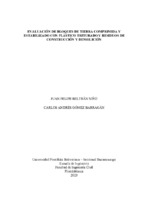Evaluación de bloques de tierra comprimida y estabilizado con plástico triturado y residuos de construcción y demolición

Date
2023xmlui.dri2xhtml.METS-1.0.item-advisor
Retamoso Llamas, Claudia Patricia
xmlui.dri2xhtml.METS-1.0.item-type
Trabajo de Grado
Citación
Metadata
Show full item recordDocuments PDF
Abstract
La sociedad sufre problemas como el precio de los materiales de construcción y de las viviendas, sumándose al daño
ecológico generado por la manufactura, construcción y demolición. En los tiempos modernos se busca solucionar con
métodos de construcción sostenibles para reducir el problema. La construcción con tierra es una técnica milenaria,
ecológica, económica, asequible y reutilizable; El presente proyecto tiene como objetivo evaluar la viabilidad de
aditivos como residuos de construcción y plástico, buscando darles un segundo uso y analizar el cambio en sus
propiedades mecánicas e higroscópicas a través de seis ensayos, los cuales son: resistencia a la flexión, resistencia a
la compresión, erosión, abrasión, densidad y permeabilidad al agua. Esto se aplicará a cinco grupos que se
compararán con BTCE 100% tierra, así BTCE con 30% RCD, BTCE con 4% plástico, BTCE con 27% RCD y 3%
plástico, BTCE con 28% RCD y 2% plástico y BTCE con 29% RCD y 1% plástico. De acuerdo con los resultados de
todas las pruebas y luego de la comparación con todos los grupos, se concluyó que las mejores dosificaciones fueron
el BTCE con 30% RCD y BTCE con 28% RCD y 2% plástico. Esta investigación también compara el ciclo de vida
de la unidad de albañilería de perforación horizontal y el bloque BTC convencional, analizando sus diversas
características como propiedades mecánicas, consumo de energía para su producción, materiales y equipos
requeridos. Society suffers from problems such as the price of construction materials and housing, adding to the ecological
damage generated by manufacturing, construction, and demolition. In modern times, solutions are sought with
sustainable construction methods to reduce the problem. Earth construction is an ancient, ecological, economical,
affordable, and reusable technique; The objective of this project is to evaluate the viability of additives such as
construction and plastic waste, seeking to give them a second use and analyze the change in their mechanical and
hygroscopic properties through six tests, which are: resistance to flexion, resistance to compression, erosion,
abrasion, density, and water permeability. This will be applied to five groups that will be compared with BTCE
100% earth, thus BTCE with 30% RCD, BTCE with 4% plastic, BTCE with 27% RCD and 3% plastic, BTCE with
28% RCD and 2% plastic and BTCE with 29% RCD and 1% plastic. According to the results of all the tests and after
the comparison with all the groups, it was concluded that the best dosages were the BTCE with 30% RCD and BTCE
with 28% RCD and 2% plastic. This research also compares the life cycle of the horizontal drilling masonry unit and
the conventional BTC block, analyzing its various characteristics such as mechanical properties, energy consumption
for its production, materials, and equipment required.
Keyword/s
BTCE
Plástico
RDC
Mezclas
Construcción
Tierra
Bloque
Compresión
Flexión
Ladrillo
Collections
- Trabajos de grado [6493]
The following license files are associated with this item:

